That structure around the zener diodes is a standard class AB amplifier stage. Here's a simplified schematic showing the principle. I borrowed the picture from this site.

Note the two Vbias batteries (or voltage sources), they are needed to make the transistors operate at the right biasing point.
Here the signal is applied "in the middle" between both batteries, in your Marantz's schematic the signal is applied at both bases of the transistors. For the operation of the circuit that does not make much difference as there will always be 2 * Vbias between both bases.
The Marantz's circuit there are emitter resistors which are not present here.
True, these make the biasing current less dependent on the precise value of Vbias. In my principle circuit, if Vbias is increased slightly, the biasing current (collector currents of the transistors) will increase more than just slightly as Ic responds in an exponential way to Vbe. Adding resistors in series with the emitters make that behavior much less "violent". Then a slight increase of Vbias will only cause a slight increase of the biasing current.
In the Marantz's circuit the Vbias sources are implemented with a zener diode in series with a standard silicon diode. This is probably done for temperature behavior, the silicon diode will have the same temperature behavior as the transistor's Vbe so the biasing current become less dependent on temperature.
The zener diode isn't that critical, as long as it make a voltage drop of the correct voltage the circuit will work. So using a zener diode rated for a higher power should not be any issue, it will still drop about 3.6 V, same as the original zener diodes.
The audio signal should not be affected by this as this amplifier uses feedback (resistor 3286) to minimize distortions.
So yes, it is perfectly fine to use 3.6 V, 1.3 W zener diodes as a replacement.
Edit:
Actually the implementation is a bit different, as Jot commented correctly, the zener diodes are only for protection, they limit the maximum value of the value of Vbias (prevent it from getting too large). The actual value of Vbias is set by the "zener diode circuit" around NPN transistor 7258 (left of those zener diodes).
Note the +1.6 V and -1.6 V notes at the bases of the NPN and PNP (7272 and 7274), that's 3.2 V across two 3.6 V zener diodes + 2 standard diodes: these diodes will never conduct in normal operation.

